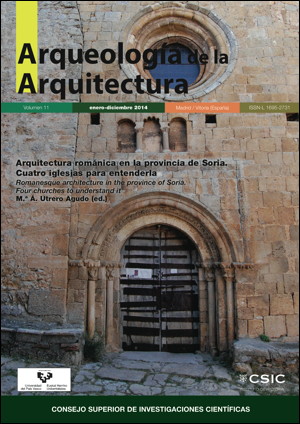La chiesa dei Santi Sergio e Bacco, Umm as-Surab (Giordania). Risultati storico-costruttivi dall’analisi archeologica degli elevati
DOI:
https://doi.org/10.3989/arq.arqt.2014.015Palabras clave:
Hawrān, villaggi rurali, epoca bizantina, periodo islamico, tecniche costruttive, rilievo tridimensionaleResumen
[it] Il contributo di seguito presentato illustra i risultati delle indagini archeologiche effettuate sugli elevati della chiesa dei Santi Sergio e Bacco nel villaggio di Umm as-Surab, Giordania settentrionale. L’edificio, ancora relativamente ben conservato, è considerato dalla letteratura specialistica come una tra le chiese più interessanti del sud Hawrān per alcune caratteristiche tecnico-strutturali, tra cui l’alta torre costruita sulla prothesis. L’ analisi dei resti materiali ci ha permesso di individuare una sequenza edilizia suddivisa in cinque periodi e di approfondire le dinamiche di cantiere. Ci siamo inoltre concentrati sull’individuazione delle principali tecniche costruttive (murature, aperture, archi e pilastri), che faranno parte di un più ampio Atlante Cronotipologico della regione dello Hawrān. Con questi nuovi dati abbiamo ulteriormente riflettuto sulle tipologie edilizie della torre e della chiesa, cercando di contribuire al dibattito corrente.
Descargas
Citas
Ambraseys, N. 2009: Earthquakes in the Mediterranean and Middle East: A Multidisciplinary Study of Seismicity up to 1900. Cambridge University Press, Cambridge, UK. http://dx.doi.org/10.1017/CBO9781139195430
Arbeiter, A. 2010: "La llamada a la oración y la servicio religioso. Campanas y campanarios de los cristianos hispánicos anteriores al románico", Boletín de Arqueología Medieval Espa-ola, 14, pp. 21-53.
Bader, N. 2009: Inscriptions Grecques et Latines de la Syrie. Inscriptions de la Jordanie-La Jordanie du Nord-Est. Fascicule I. IFPO, Beyrouth.
Bartoccini, R. 1941: "Un decennio di ricerche e di scavi italiani in Transgiordania", Bollettino del Reale Istituto di Archeologia e Storia dell'Arte, 9, pp. 1-10.
Bessac, J.C. 2010: "Le basalte de Syrie du Sud: quelques repères techniques, économiques et chronologique", in al-Maqdissi M., Braemer F., Dentzer J. M. (eds.), Hauran V. La Syrie du Sud du néolithique à l'Antiquité tardive. Recherches récentes. Actes du colloque de Damas 2007, pp. 413-423. IFPO, Damas.
Bloom, J.M. 1991: "Creswell and the Origins of the Minaret", Muqarnas VIII: An Annual on Islamic Art and Architecture, Leiden, E.J. Brill, pp. 55-58. http://dx.doi.org/10.2307/1523153
Bloom, J.M. 1993: "Mosque towers and church towers in Early Medieval Spain", in Gaehtgens T.W. (ed.), Ku.nstlerischer Austausch. Artistic exchange. Akten des XXVIII. Internationalen Kongresses fu.r Kunstgeschichte (Berlin 1992), t. 1, pp. 361-371. Berlin.
Brown, R. M. 2009: "The Druze Experience at Umm al-Jimal: Remarks on the History and Archaeology of the Early 20th Century Settlement", Studies on the History and Archaeology of Jordan, 10, pp. 377-388.
Bucarelli, O. 2007: "Umm es-Surab (Giordania). Indagini archeologiche topografiche nel settore ovest", Temporis Signa, II, pp. 309-331.
Butler, H.C. 1909: II.A.2., Ancient Architecture in Syria, Division II, Section A, Part 2, The Sourthern Hauran. Leiden.
Butler, H.C. 1913: II.A.3, Ancient Architecture in Syria, Division II, Section A, Part 3, Umm idj-Djimal. Leiden.
Butler, H.C. 1914: II.A.4, Ancient Architecture in Syria, Division II, Section A, Part 4, Bosra. Leiden.
Caballero Zoreda, L. e Mateos, P. 2000 (ed.): Visigodos y Omeyas. Un debate entre la antigu.edad tardía y la alta edad media, Anejos de Aespa XXIII. Madrid.
Clauss-Balty, P. 2008 (ed.): HAURAN III. L'Habitat dans les campagnes de Syrie du Sud aux époques classique et médiévale. Institut francais du Proche-Orient, Beyrouth.
Creswell, K.A.C. 1926 (ristampa s.i.l. 2010): "The Evolution of the Minaret, with Special Reference to Egypt", Burlington Magazine for Connoisseurs, 48, pp. 135-140, 252-258, 290-298.
Creswell, K.A.C. 1979: Early Muslim Architecture. Umayyads (622-750). Second Edition, New York.
Dentzer, J.M. 1985 (ed.): Hauran I. Recherches archéologiques sur la Syrie du Sud a l'èpoque hellénistique et romaine, Première partie, Bibliothèque archéologique et historique, tome CXXIV, Paris.
De Vries, B. 1998 (ed): Umm el-Jimal. A Frontier Town and its Landscape in Northern Jordan, Portsmouth.
Di Segni, L. 1999: "Epigraphic documentation on building in the provinces of Palestine and Arabia, 4th-7th c", in Humphrey, J.H. (ed.), The Roman and Byzantine in Near East, II-Journal of Roman Archaeology, Supplementary Series, n. 31, pp. 149-178. Portsmouth (Rhode Island).
Di Segni, L. 2009: "Greek inscriptions in transition from the Byzantine to the early Islamic period", in Cotton, H.M. et alii (eds.), From Hellenism to Islam. Cultural and linguistic change in the roman near east, pp. 352-373. Cambridge University Press, Cambridge.
Dussaud, R. e Macler, F. 1901: Voyage archéologique au Safa et dans le Gebel Druze, Paris.
Graham, C.C. 1858: "Explorations in the Desert East of the Hauran and in the Ancient Land of Bashan", Journal of the Royal Geographical Society, 28, pp. 226-263. http://dx.doi.org/10.2307/1798322
King, G.R.D. 1983a: "Byzantine and Islamic sites in northern and eastern Jordan", in Proceedings of the Sixteenth Seminar for Arabian studies vol. 13, held at Oxford on 20th-22nd July 1982, pp. 79-91. Archaeopress, Oxford.
King, G.R.D. 1983b: "Two Byzantine Churches in Northern Jordan and their Re-Use in the Islamic Period", Damaszener Mitteilungen, 1, pp. 111-136.
Krautheimer, R. 1965: Early Christian and Byzantine Architecture. Yale University Press.
Littmann, E. (with Magie jr., D. and Reed Stuart, D.) 1910: III.A.2. Greek and Latin Inscriptions in Syria, Division III, Section A, Part 2, Southern Hauran. Leiden.
Michel, A. 2001: Les Églises d'époque Byzantine et Umayyade de la Jordanie. V-VIII siècle. Turnhout.
Mittmann, S. 1966: "The Roman Road from Gerasa to Adraa", Annual of the Department of Antiquities of Jordan, 11, pp. 65-87.
Negev, A. 1973: "The staircase tower in Nabatean Architecture", Revue Biblique, 80, pp. 364-383.
Negev, A. 1988: The Architecture of Mampsis. The Late Roman and Byzantine Period, vol. II. Jerusalem.
Parenti, R. 2011: "Minareti e Campanili", Arkos, 24, pp. 58-62.
Russell, K.W. 1985: "The Earthquake Chronology of Palestine and Northwest Arabia from the 2nd through the Mid-8th century A.D.", Bulletin of the American School of Oriental Research, 260, pp. 37-59. http://dx.doi.org/10.2307/1356863
Sartre-Fauriat, A. 2004: Les voyages dans le H.awrān (Syrie du Sud) de William John Bankes (1816 et 1818). Beyrouth.
Schumacher, G. 1893: "Ergebnisse meiner Reise durch Hauran, Adschlun und Belka", Zeitschrift des deutschen Palästina-Vereins, 16, pp. 72-83 e 153-170.
Schumacher, G. 1895: "Bericht u.ber meine Reisen im Hauran", Mitteilungen und Nachrichten des deutschen Palästina-Vereins, 1, pp. 33-35.
Villeneuve, F. 1985: "L'économie rurale et la vie des campagnes dans le Hauran antique (Ier siècle av. J.C.-VIIe siècle ap. J.C.). Une approche", in Dentzer, J.-M. (ed.), Hauran I, recherches archéologiques sur la Syrie du Sud a L'époque hellénistique et romaine (première partie), Bibliothèque archéologique et historique, tome CXXIV, pp. 63-136. Paris.
Publicado
Cómo citar
Número
Sección
Licencia
Derechos de autor 2014 Consejo Superior de Investigaciones Científicas (CSIC) - Universidad del País Vasco/Euskal Herriko Unibertsitatea (UPV/EHU)

Esta obra está bajo una licencia internacional Creative Commons Atribución 4.0.
© CSIC. © UPV/EHU. Los originales publicados en las ediciones impresa y electrónica de esta Revista son propiedad del Consejo Superior de Investigaciones Científicas y de la Universidad del País Vasco/Euskal Herriko Unibertsitatea, siendo necesario citar la procedencia en cualquier reproducción parcial o total.
Salvo indicación contraria, todos los contenidos de la edición electrónica se distribuyen bajo una licencia de uso y distribución “Creative Commons Reconocimiento 4.0 Internacional ” (CC BY 4.0). Consulte la versión informativa y el texto legal de la licencia. Esta circunstancia ha de hacerse constar expresamente de esta forma cuando sea necesario.
No se autoriza el depósito en repositorios, páginas web personales o similares de cualquier otra versión distinta a la publicada por el editor.















